Electric blue crayfish are becoming an incredibly popular freshwater or brackish water tank mate to many fish and other marine life. They certainly live up to their name with brilliantly bright blue coloring that stands out from the crowd.
Electric blue crayfish are more than just a pretty face, however.
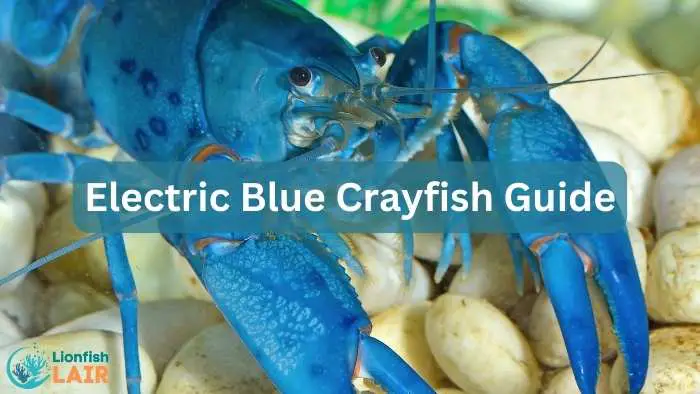
These invertebrates are excellent housekeepers! They are well known, and well loved, for their cleaning and waste removal services.
As with any living creature, you need to be informed about their care and feeding needs before you acquire them. They might be handy cleaners, but they still need looking after.
In this guide we will take you through everything you need to know about keeping electric blue crayfish, covering everything, from tank setup, to diet, and general behavior.
Electric Blue Crayfish General Information
They are the only crayfish native to Florida, hence their other name, "Florida Crayfish". Additionally, their scientific name is Procambarus alleni.
They can be found in the eastern part of the state, with the St John River acting as a natural boundary. Typically, they are not found any further north than Levy or Marion County, FL. But they also sometimes appear in the Florida Keys.
As a freshwater species, they spend their time living in rivers, lakes, and even the Everglades; in fact, they particularly thrive in the marshes of the Florida Everglades.
The electric blue crayfish is an invertebrate, which means that it does not have a spine. Instead, it relies on its exoskeleton to protect its internal organs. The exoskeleton is shed a few times a year to make room for growth.
It is the tougher exoskeleton that is responsible for the brilliantly blue coloring of these crayfish. Underneath that tough exterior, they tend to be a dull gray or pinkish red color.
Lifespan
Electric blue crayfish have a relatively long lifespan. With proper care and attention, they typically live to be 5 or 6 years old. In the aquatic world, that is a fair old time! If you want your crayfish to live long and prosper, you’ll need to keep on top of water changes and testing.
You see, electric blue crayfish are prone to ammonia poisoning. Frequent water changes can reduce the amount of ammonia they are exposed to, thus prolonging their lives.
Size
While these crustaceans resemble lobsters, they are much smaller. Ocean going lobsters may grow as large as 4 feet, but these cray fish tend to stop at 4 inches (10 cm)! If you’re lucky, they’ll top out at 6 inches (15 cm).
Despite the small size, these creatures make a big difference to any tank they are placed in, thanks to their cleaning skills.
Appearance and Coloration
When you look at an electric blue crayfish, the first thing you’ll notice is that beautiful blue coloring. It is absolutely gorgeous! Part of what makes them so captivating is the fact that you don’t see many creatures with natural blue colors in the wild.
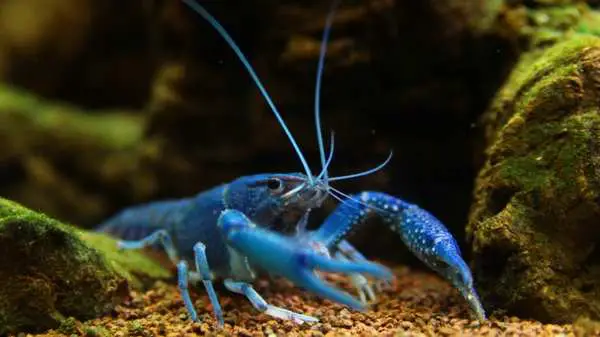
The reason that these crayfish are so vibrant is that they lack the gene to produce other pigments. This means that the blue is not diluted or washed out by yellows or reds. In the wild, Florida crayfish tend to have less vibrant colors.
This is because they haven’t been so selectively bred. Captive, pet crayfish are bred from crayfish that carry the genetic mutation that makes them blue. Even in captive bred crayfish, the coloring can vary. Some a brilliant, cobalt blue, while others are a darker navy shade.
Most of the time, the crayfish will have a base shell that is spotted and flecked by darker blue spots. They may also have white patches or highlights on the underside of their body. The dapple effect from all these different shades of blue makes these crayfish look like they’re sizzling with electricity.
It is fair to assume that this is where they got their name. Just like us, Florida crayfish can become pale and washed out if they are sick. The temperature of the water, and their diet, may also have an effect on their signature color.
BodyShape
In terms of their body structure, electric blue crayfish are very similar to lobsters, though they have a few unique features. When you look at a crayfish, you’ll notice that their hard shell, or carapace, is split into lots of different segments. This allows them greater mobility while still offering them protection.
The main part of the body, where the segments are larger, is called the thorax. This part contains all the internal organs of the crayfish, including the brain. If you look at the top end of the thorax, you’ll notice some black, beady eyes. Near the eyes, you’ll also find the mouth, but this isn’t so easy to spot.
To keep the eyes and head safe from predators, crayfish have a few little nubby horns on their face. They’re quite difficult to spot, but the idea is that they deter fish or other animals from chomping down on their head. Something else grows out of their head, but these are much easier to see!
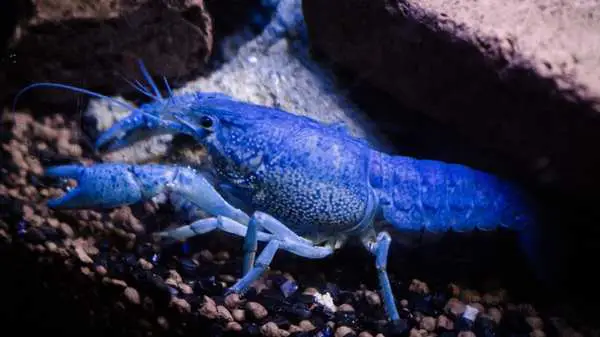
You’ll notice some antenna growing out of the front end. Usually, they have two long antennae and 2 – 4 short antennae. The long antennae are used to help the crayfish establish the layout of an area. They use them like a white cane to sweep the area and identify cracks, crevices, and rocks. The smaller antennae are more specialized. They are chemical receptors that can sniff out food, mates, and predators.
They are also more flexible, which allows them to sense motion and movement in the water. Again, this helps them identify food, friends, and enemies but from a safe distance.
Underneath the thorax, you’ll notice a lot of limbs! The electric blue crayfish has four pairs of legs and a pair of chelipeds. The legs are jointed to allow them greater mobility over uneven substrates and river beds. They also end in tiny little grabbers. These are used to hold onto uneven surfaces, plants, and rocks.
Most of the time, the legs are referred to as ‘walking legs’ because that’s what they’re used for. It might seem like a no-brainer, but the term helps differentiate these legs from the smaller swimmerets that look a bit like legs.
The chelipeds are the large claws or pincers. The pincers are used to catch food, crush through tougher parts of their food, or chop up food.
When they are not acting as cutlery, the chelipeds are used as a defensive weapon. They can’t break human skin, but they can be deadly to fish and other creatures.
The next part of the crayfish is called the abdomen, and it is the segmented section that leads to the tail. The abdominal muscle that sits under those segments is the major swimming muscle.
When a crayfish wants to swim, it snaps its tail down and under its body, which propels it backwards very quickly. At the same time, the small leg-like paddles on the abdomen move in sequence. These paddles are called swimmerets, and they line the underside of the tail.
In reality, crayfish don’t really swim. They use their tail and swimmerets to push themselves away from predators or threats, but they walk on their legs when they want to go anywhere.
Another interesting fact about crayfish is that they can’t actually swim forward. The tail doesn’t bend in the other direction, so they can’t propel themselves forward!
Electric Blue Crayfish Tank Setup
Now that you know all about their origin story, and general information, it makes sense to discover exactly how you can keep an electric blue crayfish in your home aquarium, and the requirements you must follow to do so.
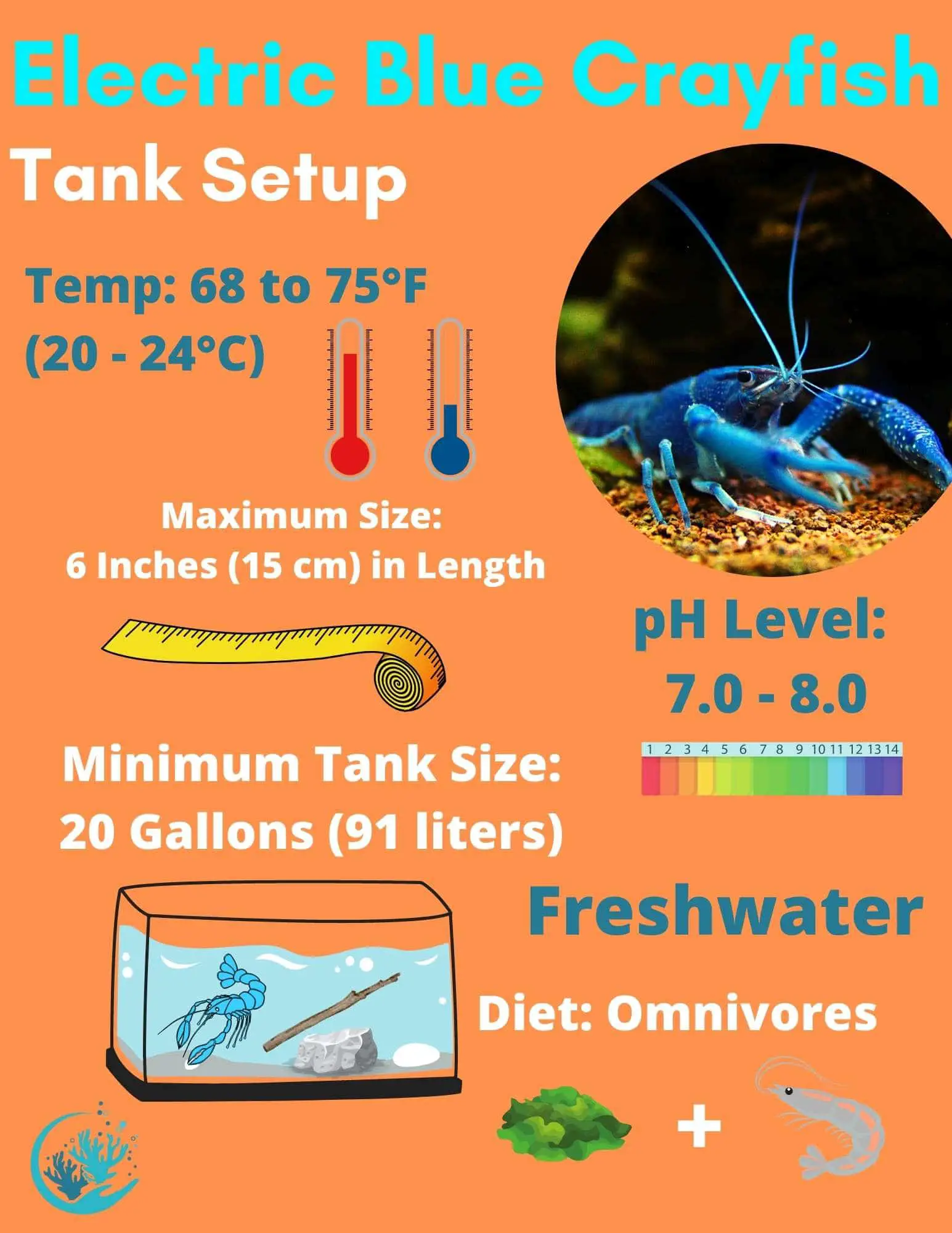
Before reading any further, remember that electric blue crayfish are freshwater animals, and under no circumstances should they be kept in a saltwater fish tank.
Below we have listed all of the necessary steps you must follow to perform a successful electric blue crayfish tank setup.
Temperature and pH Requirements
Electric blue crayfish require temperatures ranging between 68 - 75°F (20 -24°C). In terms of pH levels, crayfish prefer a neutral level of 7.0 however they will tolerate up to 8.0. You do not want the water to dip below 7.0 because this will affect the molting process.
When testing for water hardness, you're aiming for a figure between 4 and 6 KH for the carbonate hardness. General hardness should be between 6 and 8 dGH. The carbonate hardness of your water measures the amount of bicarbonates and carbonates dissolved in the water, this generally affects the pH more than the hardness of the water.
The general hardness is a measure of how much calcium and magnesium is dissolved in your water. You might think that a higher calcium level is great for your Florida crayfish especially as they need it to regenerate their exoskeletons.
However, they are quite particular and prefer a hardness of 6 to 8 which is actually quite low. Naturally, as with most fish or aquatic creatures, keep the levels of ammonia nitrate and nitrite as close to zero as possible.
Minimum Tank Size
For single crayfish, you need a tank of at least 20 gallons (75 liters). If you're going to keep more than one crayfish, you need an aquarium that measures at least 30 gallons (113.5 liters), preferably more.
This is to ensure that each crayfish has enough space to feel secure and to reduce the chances of fighting.
Tank Equipment
The first thing you’re going to need is a secure lid. Florida crayfish are good climbers, and they can be quite cheeky when it comes to trying to escape. You’re also going to need a decent filter to keep the oxygen levels high enough. Electric blue crayfish can suffocate in low oxygen water.
If you are concerned about the oxygen levels, you could add a bubbler or a resting spot that pokes out of the water. When you do select a filter, make sure to choose a canister system or a hang on back system. Crayfish are troublemakers, and they will rip standard filters apart with their claws.
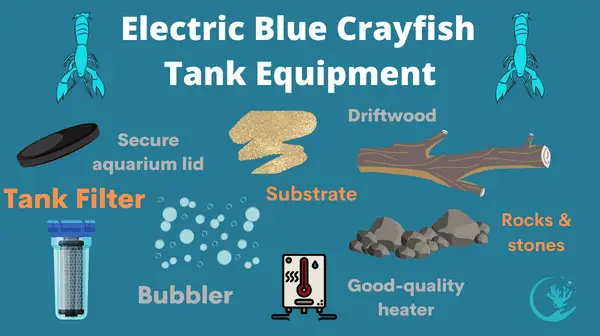
For substrate, you want something small grained that allows them to burrow. This is a natural behavior that all crayfish engage in. The final key bit of kit you’ll need are hiding spots. Crayfish like to dart between hiding spots, especially during a molt.
If you’re keeping more than one crayfish, make sure to provide hiding spots in different areas around the tank. They can and will fight over hide-outs.
General Behavior and Temperament
Electric blue crayfish are bottom feeders. This means that you’ll find them roaming the bottom of the tank at all times. They are active little crustaceans and are pretty much always on the lookout for algae and food. Part of what makes these crayfish so alluring is the fact that you can spend hours watching them move around the tank. They are always up to something, and rarely hide away.
One thing to be aware of is the fact that electric blue crayfish are opportunistic hunters. They will take a swipe at passing fish or invertebrates that are small enough to fit in their claws. Generally, they won’t be very successful at snatching fish out of the water. However, they do get creative and try to climb decorations to find a better position. To keep everyone safe and happy, choose fast swimming fish like guppies, rainbow daters and hatchetfish for tank mates.
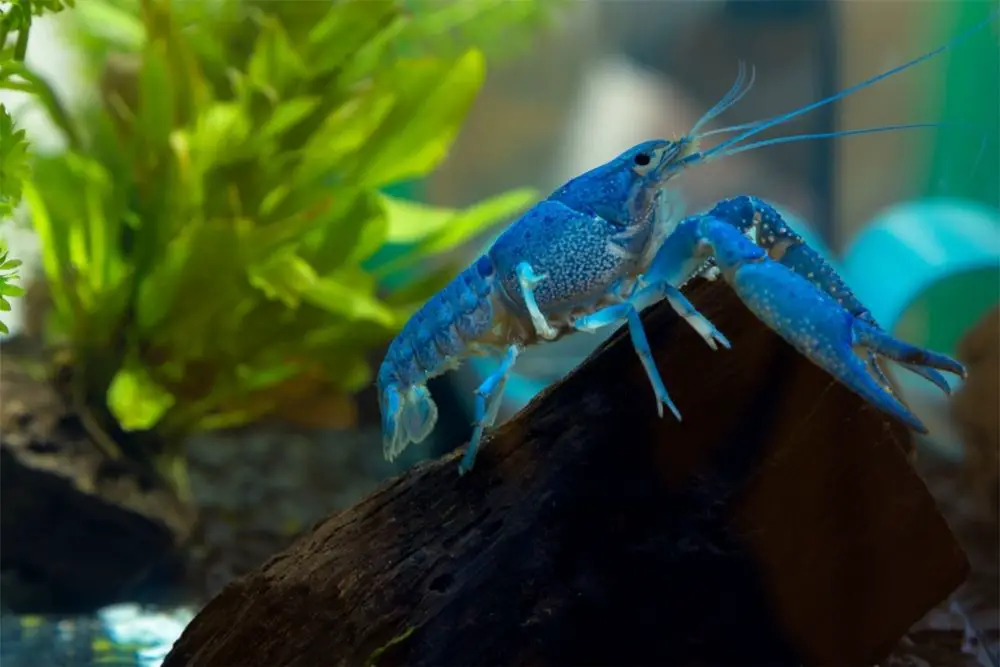
Also, if you choose fish that occupy the upper portion of the water, they’ll be far enough away from the bottom feeding crayfish. Invertebrates like shrimp and snails should not be kept with Florida crayfish. They make an excellent snack for your opportunistic crayfish! In terms of housing multiple crayfish this is absolutely fine as long as you make sure there's enough space and food to keep everyone happy. Hungry crayfish, aggressive and likely to fight other crayfish for food.
If you are going to have multiple crayfish in a tank, make sure that you introduce them all at the same time. Introducing a new crayfish to an established crayfish will likely trigger territorial behavior. When it comes to predators, you want to avoid any large aggressive and predatory fish like cichlids. These will snack on your crayfish. Unfortunately, the crayfish claws, while sharp, are no match for large aggressive predators.
Breeding
The first thing you’ll need to do if you want to breed, or prevent breeding, is correctly sex your crayfish. Males tend to have larger claws and a straighter, narrower tail than the females. However, the most definitive way to tell them apart is to flip them over and look between the legs! Males have a set of ‘claspers’ that sit between their walking legs and their swimmerets. They typically form a ‘V’ shape when they’re not in use.

When they are in use, they grab hold of the female to secure the male as he delivers his sperm. Females, on the other hand, do not have claspers. When you look between the legs and the swimmerets, you’ll see a gap. You may also be able to spot a rounded sperm receptacle between their last two sets of legs.
When kept in happy, healthy conditions, crayfish will readily mate. The male will mount the female and grab hold with his pincers and his claspers. Things can get aggressive after the deed is done, so make sure to keep a close eye on the happy couple. If correctly fertilized, the female will begin ‘berrying,’ which is when the female produces and carries her eggs under her tail.
The number of eggs in the cluster can vary from 50 to hundreds. When you spot a berrying female, you need to take her out of the general tank and put her in a separate 10-gallon (38 liter) tank. This is to protect her and the eggs from being attacked or eaten by the other tank inhabitants. The eggs take about 20 or 30 days to hatch, but the mother will only care for the babies for a few days. During this time, they will ride on her back or under her tail.
You’ll need to remove the mother from the breeding tank after about three days or she will start eating the babies. Once you notice the little ones leaving her tail or back, take her out! As the babies grow, they will shed their exoskeletons a number of times. You’ll need to keep a close eye on them because larger babies will start eating littler ones. It’s a good idea to remove the larger kiddos before they start snacking on their siblings.
Molting
One of the key and unique behaviors of crayfish is the fact that they molt their exoskeleton. Molting happens when the crayfish becomes too large for its current exoskeleton. In the first year of their life, malting is more frequent. Baby crayfish, for example, will molt every few days to facilitate their growth.
As they grow a little larger, juveniles tend to molt every one to three weeks. Typically, adult crayfish will molt every 4 to 8 weeks. During this time, they shed the hard protective carapace and are particularly vulnerable to attack. During molts, it is important for the crayfish to have a space to retreat to. This helps them feel safe and secure at their most vulnerable time. The malting process takes between 24 and 72 hours, depending on the size of the crayfish and the tank conditions.
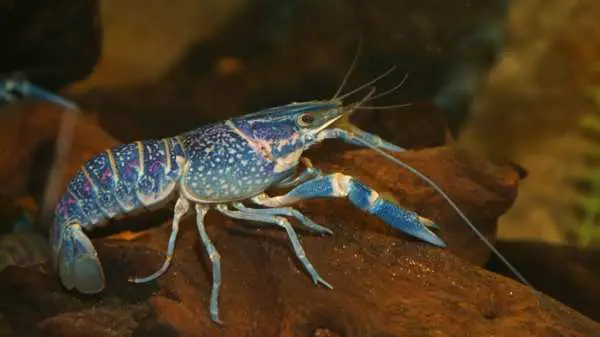
The first part of the molting phase is called the pre-molt period. During this time, crayfish stop eating and look for a place to shelter. The actual molting of the older carapace only takes a few minutes. The exoskeleton splits along the thorax region, and the crayfish wiggles its way out by flapping its tail. The next phase is called the soft phase. During this time, the soft exposed exoskeleton expands to meet the dimensions of the crayfish. The final stage of molting is called the post molt phase. During this time. Calcium is absorbed and stored in the body, which then hardens the softer outer skeleton.
Diet and Feeding
Electric blue crayfish are opportunistic omnivores. They will eat whatever they can get their sharp claws on. When captain tanks, they will feed on plants, algae, and detritus that lays at the bottom of a tank. They will also try to snatch their tank mates out of the water, but they're mostly unsuccessful if the fish are capable swimmers.
You are going to need to feed your crayfish every day. Their appetite is too large to rely on the algae and waste in a tank. A general diet could consist of sinking pellets, flakes, or allergy wafers. You can also supplement this with fresh veg or blanched vegetables. You are also going to need to offer them sources of calcium. This is crucial as it allows them to shed and harden their exoskeletons.
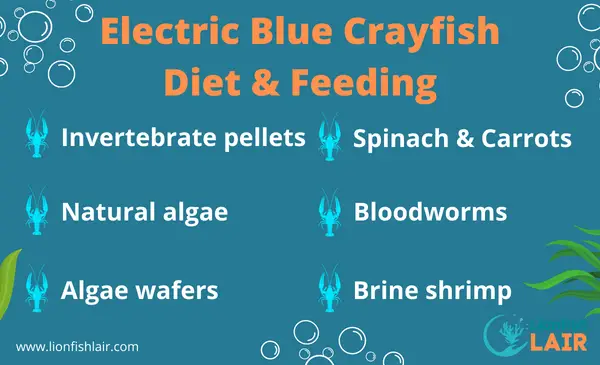
You could offer them some cuttlebone or calcium supplements to boost their calcium intake. Remember to remove any uneaten food from the tank, especially fresh vegetables, after a day. Don't overfeed the crayfish, this can cause health concerns and alter the tank conditions. However, it is also important not to underfeed your crayfish. Hungry crayfish are likely to attack their tank mates.
Conclusion
We hope this guide has been a useful resource for you and your newly acquired electric blue crayfish. It is incredibly important that you set your crayfish up correctly, with all the necessary requirements being met. This will give your crayfish the best chance of living a healthy and ultimately happy life.
